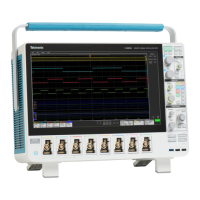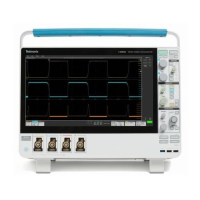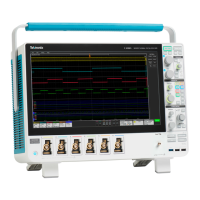A few other things to remember when saving and recalling setups:
■
Recalling a setup replaces the current setup with the recalled setup. If you do not want to lose your current setup, save the
setup file for later recall.
■
Saved setups may contain settings inappropriate for waveforms currently in your instrument. For example, if you save a
setup that displays a math waveform that is the average of reference waveform 1, when you recall the setup, if the reference
is empty, the math and reference waveforms are not displayed.
What do you want to do next?
Learn about saving and recalling waveforms.
Learn about exporting waveform data.
Saving and recalling waveforms
This instrument can save any number of waveforms, limited only by the space that you have to store them.
By saving a waveform, you can recall it at a later time for comparison, evaluation, and documentation. This is helpful when you
want to:
■
Recall a waveform for further evaluation or comparison with other waveforms.
■
Extend the waveform carrying capacity of the instrument. The instrument supports four reference, four channel, and four
math waveforms. If you want more than four reference waveforms, you can save additional references to disk for recall later.
The Reference Setup control window contains a Label field for including comments with your saved waveforms.
If you do not have an attached keyboard, you can still enter comments and name reference waveform files. The Reference Setup
control window includes a pop-up keyboard that you can use with your mouse or the touch screen to enter the waveform path
name, file name, and comments.
The instrument recalls each waveform into one of the reference waveform locations Ref <1–4>. You cannot recall into a channel
or a math waveform.
What do you want to do next?
Learn about saving and copying waveform data.
Learn about saving and recalling setups.
.
Saving and copying waveform data
This instrument supports saving waveform data to a file. The instrument can save waveforms, images, and measurements in
several formats. You can also copy waveform data to the Windows clipboard for use with other applications, such as
spreadsheets or math analysis applications.
A few things to remember when saving waveform data:
■
Waveform data are saved as a series of comma-separated values (CSV), which are amplitudes without units. There is no
timing information, but data is placed in the file in sequence from the first sample in the waveform record to the last.
■
Because the waveform data are saved as CSV, without timing and scaling information, the instrument does not save these
waveforms directly. (It only saves the data.) If you intend to recall a waveform later, save it (see the procedure Saving A
Waveform) using the .wfm file type.
■
You may also choose to copy a waveform and paste it directly into an application such as Microsoft Word or Excel. If so,
select your waveform, and then select Copy in the Edit menu.
Oscilloscope reference
742 DPO70000SX, MSO/DPO70000DX, MSO/DPO70000C, DPO7000C, and MSO/DPO5000B Series

